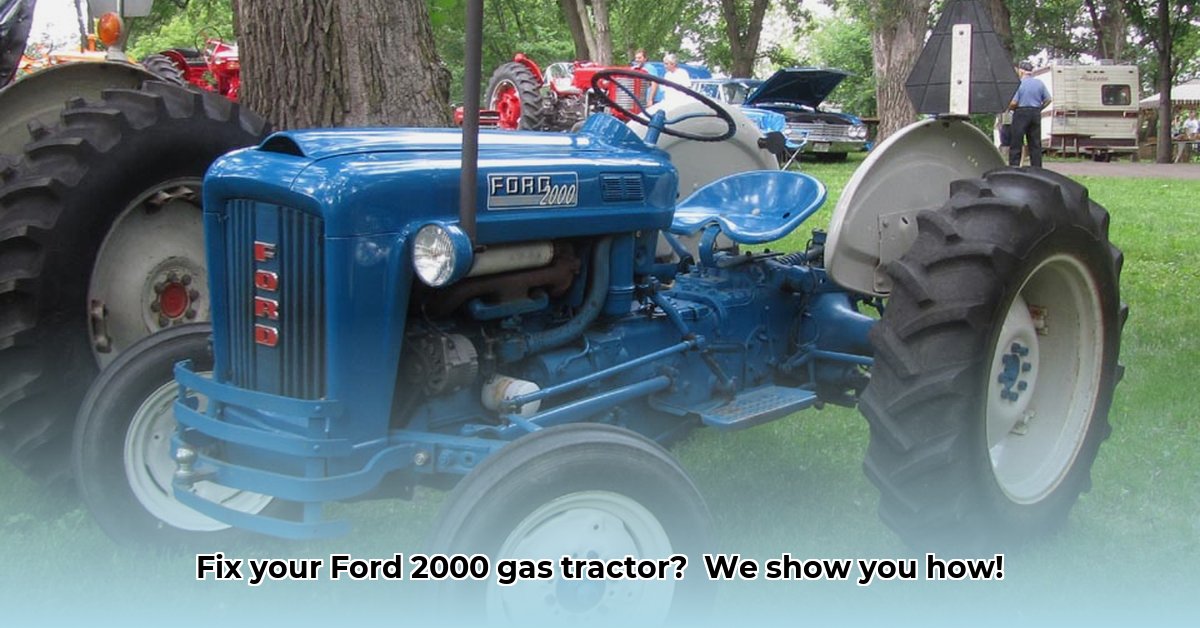
This comprehensive guide provides a step-by-step process for restoring your classic Ford 2000 gas tractor, blending historical context with practical, actionable advice for both novice and experienced restoration enthusiasts. Whether you're tackling a minor tune-up or a complete overhaul, this guide will help you bring your Ford 2000 back to its former glory.
Getting to Know Your Ford 2000 Tractor: Identification and Assessment
Before you start turning wrenches, accurately identifying your specific Ford 2000 model is paramount. This isn't just about satisfying your curiosity; it's crucial for sourcing the correct parts and utilizing the appropriate service manuals. The tractor's serial number, usually located on a plate affixed to the chassis, will be your primary identifier. This number unlocks vital information about the engine, transmission type, and other key specifications. Online resources dedicated to vintage Ford tractors can be invaluable in deciphering this information. Take detailed photos of your tractor, noting any unique features or existing damage—these visuals will serve as a valuable reference throughout the restoration process.
Disassembly: A Methodical Approach to Restoration
Safety is paramount! Always wear appropriate safety glasses and gloves, and work in a well-lit area. Before you begin disassembling your Ford 2000, thoroughly document its current condition with detailed photographs from multiple angles. This detailed visual record will serve as your guide during reassembly. As you disassemble, meticulously label each component and its associated parts (bolts, screws, etc.), using numbered bags or clearly marked containers. Keeping track of every piece is essential to ensure a successful reassembly. This detailed approach minimizes the risk of errors and ensures a smoother restoration process. Consider creating a photographic log as well, noting the position of each component.
Sourcing Parts: Original, Reproduction, and Creative Solutions
Finding the right parts is a critical step in any restoration project. Ideally, you'll source original Ford parts, ensuring authenticity and a perfect fit. However, original parts can be rare and expensive. High-quality reproduction parts are readily available from numerous suppliers specializing in classic tractor parts. These often offer a reliable and cost-effective alternative to original components. Finally, you might need to get creative; identifying alternative solutions and adapting parts from different sources may be necessary, demonstrating your ingenuity and problem-solving skills. Remember to cross-reference all parts with your service manual.
Engine Restoration: A Deep Dive into the Heart of Your Ford 2000
The engine, the heart of your tractor, requires precision and care. Thoroughly clean and inspect all components. Replace worn or damaged parts, paying close attention to details. If you lack the expertise or experience with engine rebuilding, consider enlisting the help of an expert. An improperly rebuilt engine can lead to further, more expensive problems down the line. Consult your service manual for detailed specifications and procedures. This is where a methodical approach and a deep understanding of the engine's mechanics is critical to restore its peak performance.
Transmission Restoration: Ensuring Smooth Power Transfer
The transmission is another critical component. Follow the same methodical approach as with the engine: careful disassembly, thorough cleaning, and replacement of worn parts. Precise attention to torque specifications and lubrication is essential when reassembling the transmission. Ensure smooth gear shifting and optimal power transfer before considering the restoration process complete. This is crucial for preventing future damage from improperly calibrated components.
Reassembly and Testing: Bringing Your Ford 2000 Back to Life
Reassembly is a methodical reverse of the disassembly process. Your detailed photographs and labeled parts will be invaluable at this stage. Carefully follow your service manual for torque specifications and correct assembly procedures. Once reassembled, thoroughly test all systems, including the engine, transmission, hydraulics, and PTO. Check fluid levels, and listen for any unusual noise or vibrations. A successful test run signals the completion of your restoration project.
Resources and Further Information
For additional resources and support, consider the following:
- Online Forums: Connect with other Ford 2000 restoration enthusiasts for advice, parts leads, and troubleshooting assistance.
- Classic Tractor Parts Suppliers: Numerous companies specialize in supplying parts for classic Ford tractors.
- Service Manuals: Original service manuals provide detailed instructions, diagrams, and specifications for your specific tractor model. These manuals are invaluable throughout the entire restoration process.
Restoring a Ford 2000 tractor is a rewarding journey, blending history, mechanics and personal satisfaction. This guide aims to simplify the process, providing you with the knowledge and confidence to bring this iconic machine back to life.